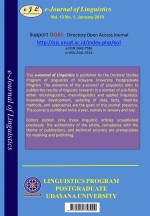Mental Predicate Feel Subtype Feel and Think in Japanese: A Natural Semantic Metalanguage Approach
Abstract
According to Goddard and Wierzbicka (2014) the original meaning of the mental predicate consists of six types namely, think, know, feel, see, hear, want and don't want. This finding was then forwarded to Japanese by Asano Cavanagh (2015), finding 12 verbs of Japanese language conditions that are matched with those found by Goddard and Wierzbicka (2014). Of the twelve state verbs that were passed on by Asano, the type FEEL was matched with the mental predicate ???kanjiru. Mental predicate???kanjiru has a subtype which turns out to produce more mental predicate than the other six types. Found subtypes FEEL and THINK, FEEL and HAPPEN, FEEL and DO, FEEL and TELL. Subtype FEEL and THINK produces 2 sub-subtypes namely FEEL and THINK (GOOD) and FEEL and THINK (BAD).
Keywords: mental predicate, feel, type, subtype
Downloads
References
Dewi Merlyna Yuda Pramesti, Putu et al. The Relationship Between The Concept of Pdr and The Practice of Brown & Levinson’s Politeness Strategies by Indonesian Caregivers in The Domain of Elderly Care in Japan. e-Journal of Linguistics, [S.l.], v. 13, n. 1, p. 13-23, jan. 2019.
Goddard, Cliff and Wierzbicka, Anna. 2014. Words and Meaning: Lexical Semantics accross Domains, Language, and Culture. United Kingdom: Oxford University Press.
Moloeng, Lexy J. 2004. Metodologi Penelitian Kualitatif. Bandung: Remaja Rosdakarya.
Sudaryanto. 2015. Metode dan Aneka Teknik Analisis Bahasa. Yogyakarta: Sanatana Dharma University Press.
Sudipa, I Nengah. 2010. Struktur Semantik: Verba Keadaan Bahasa Bali. Denpasar: Udayana University Press.
Suryasa, I Wayan et al. Application of transposition procedure to the translation of emotive words in Krsna text. e-Journal of Linguistics, [S.l.], v. 13, n. 1, p. 113-124, jan. 2019.
Wierzbicka, A. 1996. Semantics: Prime and Universal. Oxford: Oxford University.

This work is licensed under a Creative Commons Attribution 4.0 International License.

This work is licensed under a Creative Commons Attribution 4.0 International License











